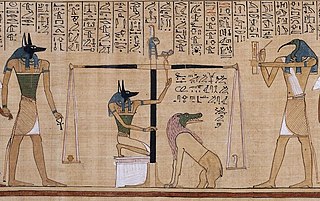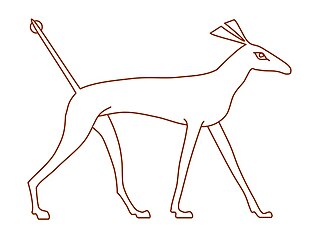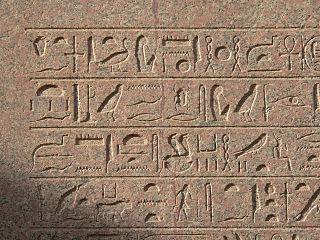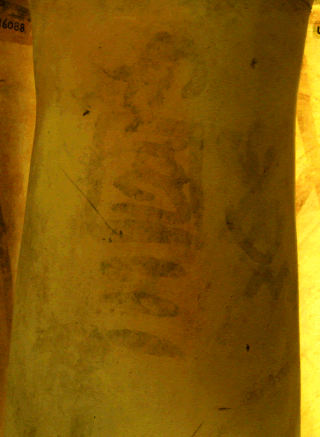
Osiris was the god of fertility, agriculture, the afterlife, the dead, resurrection, life, and vegetation in ancient Egyptian religion. He was classically depicted as a green-skinned deity with a pharaoh's beard, partially mummy-wrapped at the legs, wearing a distinctive atef crown, and holding a symbolic crook and flail. He was one of the first to be associated with the mummy wrap. When his brother Set cut him up into pieces after killing him, Osiris' wife Isis found all the pieces and wrapped his body up, enabling him to return to life. Osiris was widely worshipped until the decline of ancient Egyptian religion during the rise of Christianity in the Roman Empire.

The Egyptian language, or Ancient Egyptian, is an extinct branch of the Afro-Asiatic languages that was spoken in ancient Egypt. It is known today from a large corpus of surviving texts, which were made accessible to the modern world following the decipherment of the ancient Egyptian scripts in the early 19th century.

Egyptian hieroglyphs were the formal writing system used in Ancient Egypt for writing the Egyptian language. Hieroglyphs combined ideographic, logographic, syllabic and alphabetic elements, with more than 1,000 distinct characters. Cursive hieroglyphs were used for religious literature on papyrus and wood. The later hieratic and demotic Egyptian scripts were derived from hieroglyphic writing, as was the Proto-Sinaitic script that later evolved into the Phoenician alphabet. Egyptian hieroglyphs are the ultimate ancestor of the Phoenician alphabet, the first widely adopted phonetic writing system. Moreover, owing in large part to the Greek and Aramaic scripts that descended from Phoenician, the majority of the world's living writing systems are descendants of Egyptian hieroglyphs—most prominently the Latin and Cyrillic scripts through Greek, and the Arabic and Brahmic scripts through Aramaic.

Thoth is an ancient Egyptian deity. In art, he was often depicted as a man with the head of an ibis or a baboon, animals sacred to him. His feminine counterpart was Seshat, and his wife was Ma'at. He was the god of the Moon, wisdom, knowledge, writing, hieroglyphs, science, magic, art and judgment.

Nut, also known by various other transcriptions, is the goddess of the sky, stars, cosmos, mothers, astronomy, and the universe in the ancient Egyptian religion. She was seen as a star-covered nude woman arching over the Earth, or as a cow. She was depicted wearing the water-pot sign (nw) that identifies her.

The Book of the Dead is the name given to an ancient Egyptian funerary text generally written on papyrus and used from the beginning of the New Kingdom to around 50 BC. "Book" is the closest term to describe the loose collection of texts consisting of a number of magic spells intended to assist a dead person's journey through the Duat, or underworld, and into the afterlife and written by many priests over a period of about 1,000 years. In 1842, the Egyptologist Karl Richard Lepsius introduced for these texts the German name Todtenbuch, translated to English as 'Book of the Dead'. The original Egyptian name for the text, transliterated rw nw prt m hrw, is translated as Spells of Coming Forth by Day.

The ankh or key of life is an ancient Egyptian hieroglyphic symbol used to represent the word for "life" and, by extension, as a symbol of life itself.

The Eye of Horus, also known as left wedjat eye or udjat eye, specular to the Eye of Ra, is a concept and symbol in ancient Egyptian religion that represents well-being, healing, and protection. It derives from the mythical conflict between the god Horus with his rival Set, in which Set tore out or destroyed one or both of Horus's eyes and the eye was subsequently healed or returned to Horus with the assistance of another deity, such as Thoth. Horus subsequently offered the eye to his deceased father Osiris, and its revitalizing power sustained Osiris in the afterlife. The Eye of Horus was thus equated with funerary offerings, as well as with all the offerings given to deities in temple ritual. It could also represent other concepts, such as the moon, whose waxing and waning was likened to the injury and restoration of the eye.

Scorpion II, also known as King Scorpion, was a ruler during the Protodynastic Period of Upper Egypt.

The writing systems used in ancient Egypt were deciphered in the early nineteenth century through the work of several European scholars, especially Jean-François Champollion and Thomas Young. Ancient Egyptian forms of writing, which included the hieroglyphic, hieratic and demotic scripts, ceased to be understood in the fourth and fifth centuries AD, as the Coptic alphabet was increasingly used in their place. Later generations' knowledge of the older scripts was based on the work of Greek and Roman authors whose understanding was faulty. It was thus widely believed that Egyptian scripts were exclusively ideographic, representing ideas rather than sounds. Some attempts at decipherment by Islamic and European scholars in the Middle Ages and early modern times acknowledged the script might have a phonetic component, but perception of hieroglyphs as purely ideographic hampered efforts to understand them as late as the eighteenth century.

A lector priest was a priest in ancient Egypt who recited spells and hymns during temple rituals and official ceremonies. Such priests also sold their services to laymen, reciting texts during private apotropaic rituals or at funerals. As such, they were some of the most prominent practitioners of "magic" (heku) in ancient Egypt. In ancient Egyptian literature, lector priests are often portrayed as the keepers of secret knowledge and the performers of amazing magical feats.

The Egyptian hieroglyph Emblem of the West represents the goddess Imentet, personification of the afterlife. It is composed of a hawk or ostrich feather. The alternate version of the symbol contains the complete figure of the hawk, for Horus, with the feather extending sideways, making it similar to the iat standard, surmounted by individual gods. The feather is associated with the headdress worn by the Libyans.

The ancient Egyptian Adze on a Wood Block, or Axe in a Block of Wood hieroglyph, Gardiner sign listed no. U20, is a portrayal of the adze. It is used mostly in the cartouches of pharaonic names especially, or other important names.

The ancient Egyptian Sun hieroglyph is Gardiner sign listed no. N5 for the sun-disc; it is also one of the hieroglyphs that refers to the god Ra.

In ancient Egyptian art, the Set animal, or sha, is the totemic animal of the god Set. Because Set was identified with the Greek monster Typhon, the animal is also commonly known as the Typhonian animal or Typhonic beast.

The Egyptian hieroglyph ndj (nḏ) has the shape of a cross. It presumably depicts some type of tool such as a mill. It is often written alongside the nu "pot" hieroglyph (W24). It is used as an ideogram or determinative in the context of "grains", "grinding stone", "grind", "to rub out".

Crocodile is the provisional name of a predynastic ruler, who might have ruled during the late Naqada III epoch. The few alleged ink inscriptions showing his name are drawn very sloppily, and the reading and thus whole existence of king "Crocodile" are highly disputed. His tomb is unknown.

The Roman pharaohs, rarely referred to as ancient Egypt's Thirty-fourth Dynasty, were the Roman emperors in their capacity as rulers of Egypt, especially in Egyptology. After Egypt was incorporated into the Roman Republic in 30 BC by Octavian, the people and especially the priesthood of the country continued to recognize the Roman emperors as pharaohs, according them traditional pharaonic titularies and depicting them with traditional pharaonic garb, engaging in traditional pharaonic activities, in artwork and at temples throughout Egypt.

















